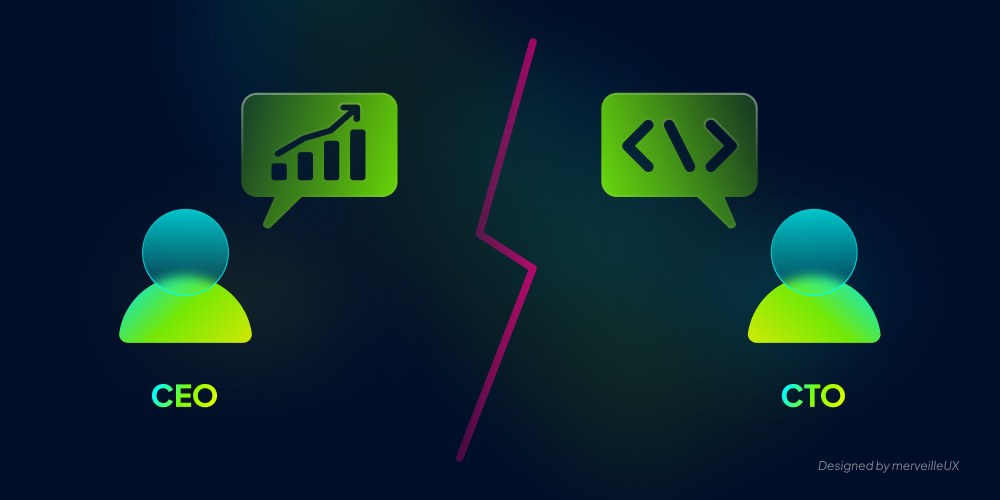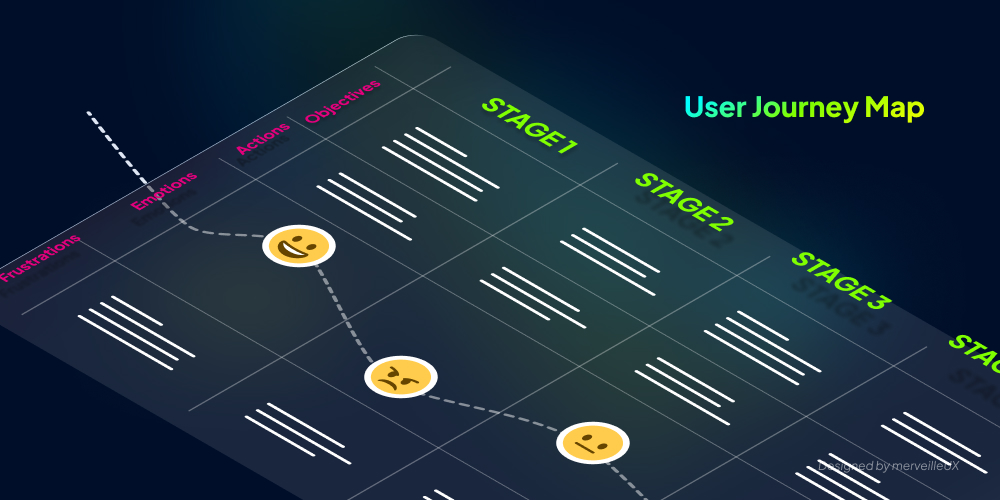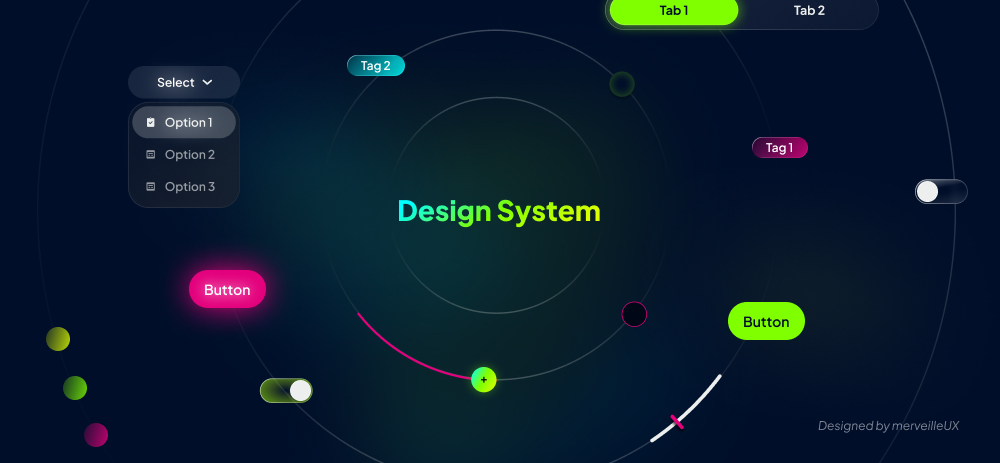The CEO talks growth, market share, and LTV. The CTO talks scalability, technical debt, and API response times. This dialogue of the deaf is a classic in SaaS. It's not just frustrating; it's incredibly expensive. Every delayed feature, every opportunity missed due to internal friction, translates into lost revenue and a surrendered competitive edge. This is the symptom of poor business-tech alignment. The root cause is almost never a lack of vision or skill. It's a lack of a common language—a bridge between business strategy and technical reality. What if that bridge already exists?
Table of contents
- Two Anxieties, One Common Enemy
- The Tool That Reconciles: The User Journey Map
- KPIs for a Shared Vision and Better Business-Tech Alignment
- The Design System: The Contract of Trust for Your Strategy
- Where to Start? Your First 3 Concrete Steps
- Conclusion: UX Isn't an Expense, It's Your Competitive Advantage
Two Anxieties, One Common Enemy
To understand the conflict, you must understand the anxieties that drive each role and poison the relationship between the two leaders.
-
The CEO's anxiety is external: the fear of irrelevance. Their mission is to keep the company relevant in its market, gain market share, and tell a compelling story. The danger comes from the outside: the competitor, the market shift, the missed opportunity. Their product vision is geared toward conquest.
-
The CTO's anxiety is internal: the fear of collapse. Their mission is to build a system that won't crumble under its own weight. The danger comes from within: accumulating technical debt, a fragile architecture, a security breach. Their vision is geared toward sustainability.
The CEO's "we need this feature for the trade show in 3 weeks!" threatens internal stability. The CTO's "we need to stop everything to refactor the database" threatens external relevance. The debate over prioritization becomes a battlefield.

This is where UX changes everything. It introduces a third, objective, and indisputable voice into the conversation: the user's voice. It's no longer the CEO versus the CTO. It's the CEO and the CTO, together, against their true common enemy: user frustration.
The Tool That Reconciles: The User Journey Map
The most powerful tool for achieving business-tech alignment is visual, concrete, and human-centered: the User Journey Map.
It's not just another design deliverable; it's a strategic map where every department can finally find its bearings and speak the same language. It breaks down the user's experience into key stages (Discovery, Consideration, Purchase, Service, Loyalty) and analyzes the user's actions, thoughts, and emotions at each one.

-
For the CEO, it's a business revelation: The map visualizes the conversion funnel. Every friction point becomes a quantifiable opportunity.
-
"Wait, we lose 30% of sign-ups at the 'Account Setup' stage? What is that churn costing us?"
-
"I see the support team is flooded with tickets about the 'Data Export' feature. How much is each ticket costing us?" Churn and costs are no longer abstract inevitabilities but localized problems ready to be solved.
-
-
For the CTO, it's a technical roadmap: The same map offers a clear perspective on the systems involved.
-
"The slowdown during setup is due to a complex query on the user database. If we optimize it, we directly improve that friction point."
-
"The export API is unstable because it's hitting memory limits on large files. By refactoring it for asynchronous processing, we can eliminate the source of those support tickets."
-
The User Journey Map transforms the conversation. It's no longer about "business vs. tech," but "how do we improve stage 3 together to cut churn by 10% and reduce server load by 15%?" Prioritization becomes logical and data-driven.
KPIs for a Shared Vision and Better Business-Tech Alignment
Alignment is proven by numbers. But you have to be looking at the same ones. UX makes it possible to directly connect the technical performance indicators (that the CTO tracks) with the business outcomes (that the CEO obsesses over).
Consider this:
-
The CEO's KPIs (The "What"): Retention Rate, Feature Adoption Rate, Net Promoter Score (NPS), Lifetime Value (LTV).
-
The CTO's KPIs (The "How"): Page Load Time (Performance), User Error Rate (Reliability), Service Uptime, Infrastructure Cost per User.
To learn more, don't miss our breakdown of the 9 key SaaS KPIs to achieve your goals.
The virtuous circle in action: Imagine the CTO and her team manage to cut the load time of the report-building page in half (a technical KPI).
-
Direct Impact: The error rate on that page drops because impatient users no longer click multiple times or give up halfway through.
-
Business Impact: The adoption rate for this key feature increases. Satisfied users are more likely to stay and use the product more deeply. The retention rate (the CEO's KPI) improves. The perceived value of the service goes up.
By focusing on improving the experience, the CTO isn't just "fixing tech problems"; she is directly and measurably contributing to the CEO's strategic goals.
The Design System: The Contract of Trust for Your Strategy

If the User Journey Map is the map, the Design System is the contract that ensures everyone builds the right way, quickly. It's a centralized library of components, rules, and principles that serves as a single source of truth for design and development.
-
The CEO's Guarantee: The Design System is the guardian of the brand identity. It ensures visual and interactive consistency across the entire product and all touchpoints. This consistency builds trust, reinforces brand recognition, and projects a professional image essential for winning market share. It's a strategic asset that supports the long-term product vision.
-
The CTO's Efficiency: For development teams, it's a phenomenal time and energy saver. No more reinventing the wheel for every new page. Components are already built, tested, secured, and optimized. This reduces technical debt, drastically accelerates production cycles, and allows developers to focus on higher-value, complex problems.
A Design System isn't a constraint; it's an accelerator. It reconciles the CEO's need for brand control with the CTO's need for efficiency, velocity, and scalability.
Where to Start? Your First 3 Concrete Steps
Convinced, but not sure where to start? You don't need to overhaul everything at once. Build momentum with simple, high-impact actions to improve collaboration.
-
Host an "Alignment Workshop" (2 hours max): Get the CEO, CTO, and the heads of Product and Support around a table. The agenda is simple: agree that user experience is a shared goal and the primary driver of growth.
-
Everyone's Role: The head of support brings the top 3 customer complaints. The CEO restates the #1 business goal for the quarter. The CTO outlines the main technical constraint of the moment.
-
The Deliverable: A collective decision to map one critical user journey—the one most directly related to the issues discussed.
-
-
Map ONE Critical Journey (and only one): Don't try to map your entire product; it's the fastest way to get discouraged. Pick the most strategic journey for you today. Is it the onboarding flow with a 50% drop-off rate? The path to a little-used premium feature?
-
How to do it: Use a whiteboard (real or virtual) and list the steps from the user's point of view. For each step, ask: "What is the user doing?", "What are they feeling?", "What are the touchpoints with our product?".
-
The Result: This simple exercise will make the concept of a User Journey Map tangible and immediately reveal 2 or 3 obvious friction points to everyone.
-
-
Connect ONE Friction Point to ONE Business KPI: This is the moment of truth. Take one of the friction points you identified.
-
Example: "Users give up when trying to import their data from another service."
-
The Translation: The CEO will see a low adoption rate and a barrier to migration. The head of support will see a flood of tickets. The CTO will see a 50% error rate on the import API and an abnormal server load.
-
The "Aha!" Moment: This is where it all clicks. Everyone realizes these aren't separate problems but different facets of the same user problem. Solving it becomes the shared priority.
-
Conclusion: UX Isn't an Expense, It's Your Competitive Advantage
User experience is not just a matter of design or "pretty interfaces." It's the operating system for your product strategy. It's the culture that elevates the conversation, turns opinions into facts, and focuses all the company's energy on what truly matters: the customer. A solid business-tech alignment is the key.
By adopting this common language, you won't just build a better product. You'll build a more resilient, faster, and higher-performing organization. That is the true secret to Product-Led Growth and an advantage your competitors can never buy.
Ready to make UX the common language of your company? Let's talk. An UX audit is often the first step to identifying friction points and aligning your teams toward this shared vision.



